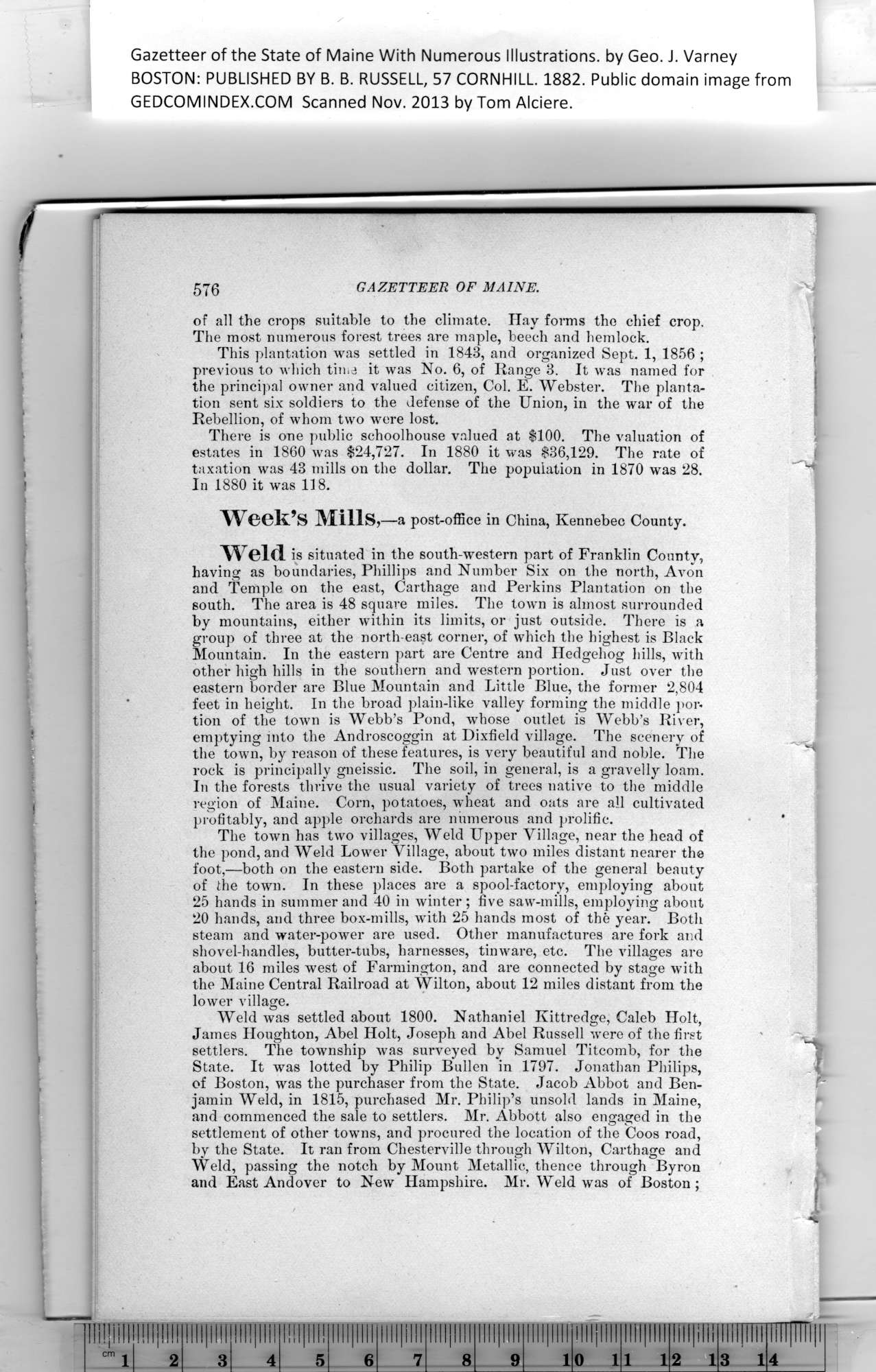|
Gazetteer of the State of Maine With Numerous Illustrations, by Geo. J. Varney
BOSTON: PUBLISHED BY B. B. RUSSELL, 57 CORNHILL. 1882. Public domain image from
of all the crops suitable to the climate. Hay forms the chief crop.
The most numerous forest trees are maple, beech and hemlock.
This plantation was settled in 1843, and organized Sept. 1, 1856 ;
previous to which time it was No. 6, of Range 3. It was named for
the principal owner and valued citizen, Col. E. Webster. The planta-
tion sent six soldiers to the defense of the Union, in the war of the
Rebellion, of whom two were lost.
There is one public schoolhouse valued at $100. The valuation of
estates in 1860 was $24,727. In 1880 it was $36,129. The rate of
taxation was 43 mills on the dollar. The population in 1870 was 28.
In 1880 it was 118.
"Week’s ivtills,—a post-office in China, Kennebec County.
Weld is situated in the south-western part of Franklin County,
having as boundaries, Phillips and Number Six on the north, Avon
and Temple on the east, Carthage and Perkins Plantation on the
south. The area is 48 square miles. The town is almost surrounded
by mountains, either within its limits, or just outside. There is a
group of three at the north-east corner, of which the highest is Black
Mountain. In the eastern part are Centre and Hedgehog hills, with
other high hills in the southern and western portion. Just over the
eastern border are Blue Mountain and Little Blue, the former 2,804
feet in height. In the broad plain-like valley forming the middle por.
tion of the town is Webb’s Pond, whose outlet is Webb’s River,
emptying into the Androscoggin at Dixfield village. The scenery of
the town, by reason of these features, is very beautiful and noble. The
rock is principally gneissic. The soil, in general, is a gravelly loam.
In the forests thrive the usual variety of trees native to the middle
region of Maine. Corn, potatoes, wheat and oats are all cultivated
profitably, and apple orchards are numerous and prolific.
The town has two villages, Weld Upper Village, near the head of
the pond, and Weld Lower Village, about two miles distant nearer the
foot,—both on the eastern side. Both partake of the general beauty
of the town. In these places are a spool-factory, employing about
25 hands in summer and 40 in winter; five saw-mills, employing about
20 hands, and three box-mills, with 25 hands most of the year. Both
steam and water-power are used. Other manufactures are fork and
shovel-handles, butter-tubs, harnesses, tinware, etc. The villages are
about 16 miles west of Farmington, and are connected by stage with
the Maine Central Railroad at Wilton, about 12 miles distant from the
lower village.
Weld was settled about 1800. Nathaniel Kittredge, Caleb Holt,
James Houghton, Abel Holt, Joseph and Abel Russell were of the first
settlers. The township was surveyed by Samuel Titcomb, for the
State. It was lotted by Philip Bullen in 1797. Jonathan Philips,
of Boston, was the purchaser from the State. Jacob Abbot and Ben-
jamin Weld, in 1815, purchased Mr. Philip’s unsold lands in Maine,
and commenced the sale to settlers. Mr. Abbott also engaged in the
settlement of other towns, and procured the location of the Coos road,
by the State. It ran from Chesterville through Wilton, Carthage and
Weld, passing the notch by Mount Metallic, thence through Byron
and East Andover to New Hampshire. Mr. Weld was of Boston;
PREVIOUS PAGE ... NEXT PAGE
This page was written in HTML using a program written in Python 3.2
|
